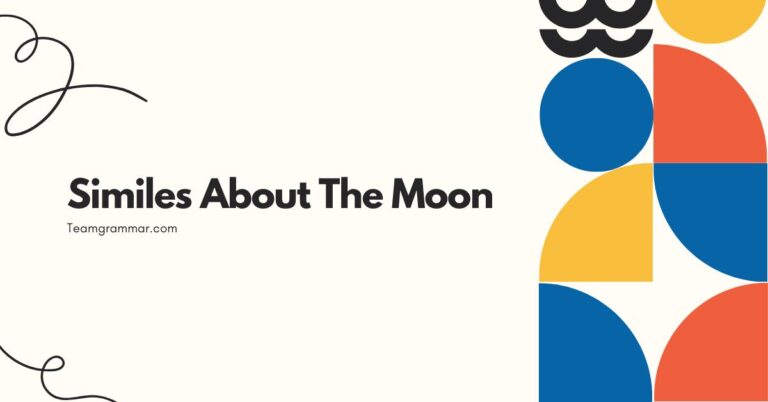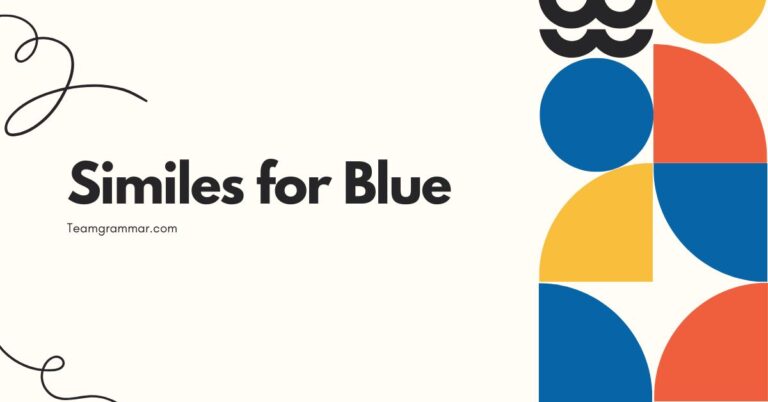45 Similes for Red: Enhancing Descriptive Language Skills
Understanding and using similes effectively can dramatically enhance your descriptive writing and communication skills. Similes, which compare one thing to another using “like” or “as,” allow you to create vivid imagery and convey deeper meaning.
This article focuses specifically on similes that evoke the color red, exploring various ways to describe redness through comparison. Whether you’re a student, writer, or language enthusiast, mastering these similes will enrich your vocabulary and improve your ability to paint pictures with words.
From the fiery intensity of a volcano to the subtle blush of a rose, we’ll cover a wide range of comparisons to make your descriptions more vibrant and engaging. This article provides definitions, examples, usage rules, and practice exercises to solidify your understanding.
Table of Contents
- Definition of Simile
- Structural Breakdown of Similes
- Types of Red and Their Similes
- Examples of Similes for Red
- Usage Rules for Similes
- Common Mistakes with Similes
- Practice Exercises
- Advanced Topics: Nuances in Simile Usage
- Frequently Asked Questions
- Conclusion
Definition of Simile
Asimileis a figure of speech that compares two unlike things using the words “like” or “as.” The purpose of a simile is to create a vivid image or to emphasize a particular quality of one thing by associating it with another. Similes are essential tools in descriptive writing and poetry, allowing writers to convey complex ideas and evoke emotions in a concise and impactful way.
They rely on the reader’s ability to understand the connection between the two things being compared. A well-crafted simile can transform a mundane description into something memorable and evocative.
Similes belong to the broader category of figurative language, which also includes metaphors, personification, and hyperbole. Unlike metaphors, which directly state that one thingisanother, similes only suggest a similarity.
This difference makes similes a more subtle and nuanced way to create comparisons. The effectiveness of a simile often depends on the originality and aptness of the comparison.
A cliché simile, while grammatically correct, may not have the desired impact on the reader. Therefore, striving for fresh and inventive comparisons is crucial for effective writing.
Structural Breakdown of Similes
The basic structure of a simile consists of three main components: thesubject, thelinking word(either “like” or “as”), and theobject of comparison. The subject is the thing being described, and the object of comparison is the thing it is being compared to.
The linking word establishes the relationship between the two. Understanding this structure is crucial for constructing grammatically correct and effective similes.
For example, in the simile “Her cheeks were as red as roses,” “her cheeks” is the subject, “as” is the linking word, and “roses” is the object of comparison. The simile suggests that her cheeks share the same redness as roses.
The strength of a simile lies in the connection between the subject and the object of comparison. The more relatable and understandable the comparison, the more effective the simile will be.
The simile should also be concise and avoid unnecessary words. Clarity and precision are key to creating a powerful image in the reader’s mind.
Let’s look at another example: “The sunset was like a fiery inferno.” Here, “the sunset” is the subject, “like” is the linking word, and “a fiery inferno” is the object of comparison. This simile evokes a sense of intense heat and vibrant color.
The effectiveness of this simile comes from the common understanding of what a fiery inferno looks and feels like. By associating the sunset with this image, the writer creates a more vivid and memorable experience for the reader.
Thus, the careful selection of the object of comparison is vital for conveying the intended meaning and emotion.
Types of Red and Their Similes
The color red is incredibly versatile, evoking a wide range of emotions and associations. To effectively use similes for red, it’s helpful to consider the different shades and contexts in which red appears.
Here, we’ll explore some common types of red and corresponding similes.
Fiery Red
Fiery red is associated with intensity, passion, and danger. Similes for this type of red often involve fire, heat, and powerful imagery.
Consider the following examples:
- As red as a dragon’s breath
- Like molten lava flowing down a volcano
- As fiery as the heart of the sun
- Red like burning embers in a fireplace
These similes convey a sense of heat, energy, and potential destruction. They are often used to describe scenes of conflict, intense emotions, or powerful natural phenomena.
The use of words like “dragon,” “lava,” and “sun” adds to the dramatic effect.
Blood Red
Blood red is often associated with violence, sacrifice, and life. Similes for this type of red can be quite stark and evocative, bringing to mind images of injury and mortality.
- As red as a fresh wound
- Like blood spilled on the battlefield
- Red as the stain of a forgotten sin
- As crimson as a poppy in a field of wheat
These similes can be used to create a sense of unease or to emphasize the gravity of a situation. The association with blood makes these similes particularly powerful and emotionally charged.
However, context is crucial when using these types of similes, as they can be quite disturbing if used inappropriately.
Romantic Red
Romantic red is associated with love, passion, and beauty. Similes for this type of red often involve roses, hearts, and other symbols of romance.
- As red as a Valentine’s heart
- Like the blush on a lover’s cheek
- Red as a rose in full bloom
- As crimson as a velvet curtain
These similes are often used in love poems, romance novels, and other contexts where the goal is to evoke feelings of affection and desire. The use of words like “rose,” “heart,” and “velvet” adds to the sense of luxury and romance.
Autumnal Red
Autumnal red is associated with the changing seasons, warmth, and nostalgia. Similes for this type of red often involve leaves, sunsets, and other images of fall.
- As red as maple leaves in October
- Like the setting sun on an autumn evening
- Red as the embers of a dying fire
- As russet as a fox’s coat
These similes evoke a sense of warmth, comfort, and reflection. They are often used in descriptions of nature, particularly in the fall.
The use of words like “maple,” “sunset,” and “fox” adds to the sense of rustic beauty and tranquility. These similes are often used to create a sense of melancholy, as they are associated with the end of summer and the coming of winter.
Examples of Similes for Red
Here are extensive examples of similes for red, categorized for clarity. Each table provides a range of comparisons to enhance your descriptive abilities.
Table 1: General Similes for Red
This table provides a broad range of similes that can be used to describe various shades and intensities of red.
| Simile | Context |
|---|---|
| As red as a cherry | Describing a bright, cheerful red. |
| Like a poppy in the summer field | Describing a vibrant, natural red. |
| As crimson as an emperor’s robe | Describing a rich, regal red. |
| Red like a stop sign on a highway | Describing an attention-grabbing red. |
| As ruby as a queen’s jewel | Describing a deep, precious red. |
| Like a cardinal perched on a branch | Describing a vivid, natural red. |
| As scarlet as a dancer’s dress | Describing a bold, theatrical red. |
| Red like the lacquer on a vintage car | Describing a polished, refined red. |
| As blood-red as a vampire’s eyes | Describing a dark, ominous red. |
| Like a fire truck speeding down the street | Describing a bright, urgent red. |
| As tomato-red as a summer soup | Describing a warm, culinary red. |
| Red like the sunset over the ocean | Describing a breathtaking, natural red. |
| As rust-red as an old barn | Describing a weathered, rustic red. |
| Like a brick wall standing strong | Describing a sturdy, earthy red. |
| As coral-red as a tropical reef | Describing a vibrant, exotic red. |
| Red like the clay in a potter’s hands | Describing a natural, earthy red. |
| As beet-red as a farmer’s face | Describing a flushed, healthy red. |
| Like a cranberry in a holiday sauce | Describing a festive, tart red. |
| As paprika-red as a spicy dish | Describing a rich, savory red. |
| Red like the inside of a pomegranate | Describing a juicy, vibrant red. |
| As lobster-red as a sunburned tourist | Describing a painful, intense red. |
| Like a chili pepper in a hot sauce | Describing a fiery, pungent red. |
| As strawberry-red as a summer dessert | Describing a sweet, delightful red. |
Table 2: Similes for Intense Red
This table focuses on similes that convey a strong, vibrant, and attention-grabbing shade of red.
| Simile | Context |
|---|---|
| As red as a siren’s wail | Describing an alarming, urgent red. |
| Like a volcano erupting with fury | Describing a powerful, destructive red. |
| As incandescent as a burning coal | Describing a glowing, intense red. |
| Red like a dragon’s fiery breath | Describing a mythical, fearsome red. |
| As fervent as a lover’s passion | Describing an emotional, intense red. |
| Like a wildfire consuming the forest | Describing a rampant, uncontrollable red. |
| As scorching as the desert sun | Describing a burning, intense red. |
| Red like the heart of a supernova | Describing a cosmic, explosive red. |
| As vibrant as a flamenco dancer’s dress | Describing a lively, energetic red. |
| Like a warning flare in the night | Describing an alerting, visible red. |
| As heated as a blacksmith’s forge | Describing a fiery, industrial red. |
| Red like the fury in a warrior’s eyes | Describing an angry, intense red. |
| As explosive as a firework’s burst | Describing a dynamic, vibrant red. |
| Like a laser beam cutting through darkness | Describing a precise, powerful red. |
| As passionate as a tango’s embrace | Describing a sensual, intense red. |
| Red like the blood of a mythical beast | Describing a fantastical, dramatic red. |
| As zealous as a revolutionary’s flag | Describing a symbolic, intense red. |
| Like a beacon guiding ships at sea | Describing a guiding, prominent red. |
| As fervent as a preacher’s sermon | Describing an impassioned, intense red. |
| Red like the rage in a bull’s eyes | Describing an aggressive, intense red. |
| As dramatic as a theater’s spotlight | Describing a theatrical, intense red. |
| Like a pulsating heart full of life | Describing a vital, energetic red. |
| As commanding as a general’s uniform | Describing an authoritative, powerful red. |
Table 3: Similes for Subdued Red
This table provides similes for describing softer, more muted shades of red, often associated with warmth and subtlety.
| Simile | Context |
|---|---|
| As muted as an old brick wall | Describing a subtle, weathered red. |
| Like a faded sunset on the horizon | Describing a soft, diminishing red. |
| As dusky as a desert twilight | Describing a shadowy, subtle red. |
| Red like the embers of a dying fire | Describing a fading, warm red. |
| As gentle as a blush on a cheek | Describing a delicate, subtle red. |
| Like a whisper of color in the dawn | Describing a faint, emerging red. |
| As soft as a worn velvet cushion | Describing a comfortable, subtle red. |
| Red like the rust on an antique tool | Describing a vintage, aged red. |
| As understated as a wine stain on linen | Describing a subtle, accidental red. |
| Like a memory of summer’s warmth | Describing a nostalgic, subtle red. |
| As soothing as a cup of herbal tea | Describing a calming, gentle red. |
| Red like the inside of a seashell | Describing a delicate, pearly red. |
| As mild as a paprika sprinkle | Describing a subtle, flavorful red. |
| Like a hazy filter over the world | Describing a muted, dreamlike red. |
| As reserved as a secret love letter | Describing a hidden, subtle red. |
| Red like the dust on an old book | Describing a historical, aged red. |
| As hushed as a library’s silence | Describing a quiet, subtle red. |
| Like a shadow cast by a setting sun | Describing a fleeting, subtle red. |
| As demure as a veiled lady | Describing a modest, subtle red. |
| Red like the glow of a distant lantern | Describing a remote, subtle red. |
| As comforting as a warm blanket | Describing a cozy, subtle red. |
| Like a gentle reminder of autumn | Describing a seasonal, subtle red. |
| As mellow as an aged port wine | Describing a rich, subtle red. |
Usage Rules for Similes
While similes are relatively straightforward, there are some rules to keep in mind to ensure their effective use. The primary rule is to ensure that the comparison is logical and makes sense to the reader.
The two things being compared should share a common characteristic that is relevant to the description.
Avoid using clichés. Overused similes like “as red as a rose” can sound unoriginal and fail to make an impact.
Strive to create fresh and inventive comparisons that will capture the reader’s attention. Another important rule is to maintain consistency in your writing style.
If you are using formal language, avoid using colloquial similes. Similarly, if you are writing in a casual style, avoid using overly complex or obscure comparisons.
Finally, be mindful of the context in which you are using the simile. A simile that is appropriate in one situation may not be appropriate in another.
Consider the tone and purpose of your writing, and choose similes that will enhance your message. For example, using a simile that is too graphic or violent in a children’s story would be inappropriate.
Common Mistakes with Similes
One common mistake is confusing similes with metaphors. Remember, a simile uses “like” or “as” to make a comparison, while a metaphor directly states that one thingisanother.
For example:
- Incorrect (Metaphor): Her cheeks were roses.
- Correct (Simile): Her cheeks were as red as roses.
Another common mistake is using illogical or nonsensical comparisons. The two things being compared should have a clear and understandable connection.
For example:
- Incorrect: The car was as red as a cloud.
- Correct: The car was as red as a fire engine.
Using mixed metaphors or similes is another error. Ensure that your comparisons are consistent and do not create confusing or contradictory images.
For example:
- Incorrect: He was as brave as a lion, but also a scaredy-cat.
- Correct: He was as brave as a lion.
Finally, avoid using similes that are too obvious or redundant. The purpose of a simile is to add depth and nuance to your description, not to state the obvious.
For example:
- Incorrect: The apple was as red as a red apple.
- Correct: The apple was as red as a ruby.
Practice Exercises
Test your understanding of similes with these exercises. Fill in the blanks with appropriate similes to complete the sentences.
Exercise 1: Basic Similes
| Question | Answer |
|---|---|
| 1. The sunset was ___________. | as red as a fiery sunset |
| 2. Her dress was ___________. | like a vibrant poppy |
| 3. The wine was ___________. | as crimson as a blood orange |
| 4. His face was ___________. | like a beet after running |
| 5. The sports car was ___________. | as scarlet as a race car |
| 6. The candy was ___________. | like a cherry lollipop |
| 7. The old house was ___________. | as rust-colored as an old nail |
| 8. The rose was ___________. | like a valentine’s heart |
| 9. The fire was ___________. | as red hot as lava |
| 10. The balloon was ___________. | like a red rubber ball |
Exercise 2: Intermediate Similes
| Question | Answer |
|---|---|
| 1. The anger in his eyes was ___________. | as red as burning embers |
| 2. The dancer’s costume was ___________. | like a splash of crimson paint |
| 3. The autumn leaves were ___________. | as scarlet as a cardinal’s feathers |
| 4. The sports drink was ___________. | like a tangy mix of berries |
| 5. The velvet curtain was ___________. | as crimson as a royal robe |
| 6. The hot sauce was ___________. | like a volcano erupting with flavor |
| 7. The old truck was ___________. | as weathered as a rusted gate |
| 8. The sunset over the hills was ___________. | like a painter’s vibrant masterpiece |
| 9. The athlete’s face was ___________. | as flushed as a summer tomato |
| 10. The fighter’s gloves were ___________. | like a blood-stained crimson |
Exercise 3: Advanced Similes
| Question | Answer |
|---|---|
| 1. The revolutionary’s flag was ___________. | as red as the fire of rebellion |
| 2. The heart of the supernova was ___________. | like a cosmic explosion of crimson |
| 3. The passion in their dance was ___________. | as scarlet as a tango’s fervent embrace |
| 4. The embers of the dying fire were ___________. | like the last whispers of summer’s warmth |
| 5. The artist’s vision was ___________. | as vivid as a dream painted in rubies |
| 6. The soldier’s courage was ___________. | like a crimson shield against despair |
| 7. The poet’s words were ___________. | as fervent as a lover’s whispered secrets |
| 8. The ancient tapestry was ___________. | like a forgotten tale woven in blood |
| 9. The wine’s bouquet was ___________. | as complex as a symphony of berries and spice |
| 10. The runner’s determination was ___________. | like a red-hot flame burning within |
Advanced Topics: Nuances in Simile Usage
For advanced learners, understanding the nuances of simile usage can elevate your writing to a higher level. This includes considering the cultural context of your similes.
A simile that resonates with one audience may not have the same impact on another. For example, a simile that references a specific cultural symbol or event may not be understood by someone from a different background.
Experiment with unusual and unexpected comparisons. While it’s important to ensure that your similes are logical and understandable, don’t be afraid to push the boundaries of creativity.
The most memorable similes are often those that are surprising and original. Consider the rhythm and sound of your similes.
The best similes not only create a vivid image but also sound pleasing to the ear. Pay attention to the rhythm and alliteration in your similes to enhance their impact.
Using similes to create a specific tone or mood. Similes can be used to evoke a wide range of emotions, from joy and excitement to sadness and fear.
Choose your similes carefully to create the desired effect. For example, using dark and ominous similes can create a sense of suspense or dread.
Finally, practice using similes in your own writing. The more you experiment with different comparisons, the better you will become at crafting effective and memorable similes.
Frequently Asked Questions
- What is the difference between a simile and a metaphor?
A simile compares two things using “like” or “as,” while a metaphor directly equates one thing to another without using these words. Similes suggest a similarity, while metaphors assert an identity.
- Why are similes important in writing?
Similes enhance descriptive writing by creating vivid imagery, conveying deeper meaning, and evoking emotions in a concise and impactful way. They make writing more engaging and memorable.
- How can I avoid using cliché similes?
Strive for originality by thinking outside the box and creating fresh, inventive comparisons. Consider unique characteristics and associations that haven’t been overused.
- What makes a simile effective?
An effective simile is logical, understandable, and creates a strong connection between the subject and the object of comparison. It should also be concise and appropriate for the context.
- Can a simile be too complex?
Yes, a simile can be too complex if it uses obscure references or requires too much interpretation from the reader. Clarity is key; ensure the comparison is easily understood.
- How do I choose the right object of comparison for a simile?
Consider the specific quality you want to emphasize and choose an object of comparison that strongly embodies that quality. Think about the associations and emotions the object evokes.
- Is it okay to use multiple similes in one paragraph?
Yes, but use them sparingly to avoid overwhelming the reader. Ensure each simile adds value and doesn’t detract from the overall clarity of the writing.
- How can I practice using similes effectively?
Read widely and pay attention to how other writers use similes. Experiment with different comparisons in your own writing and seek feedback from others.
- What role does context play in choosing a simile?
Context is crucial. The tone, purpose, and audience of your writing should all influence your choice of similes. A simile that works in one context may be inappropriate in another.
- Can similes be used in everyday conversation?
Yes, similes can add color and expressiveness to everyday conversation. However, avoid using overly formal or complex similes in casual settings.
- How to use similes to describe a feeling?
Similes can be very effective in describing feelings by comparing the feeling to a tangible experience or object. For example, “His heart was as heavy as a stone,” effectively conveys the feeling of sadness or grief.
- What are the best resources for learning more about similes?
Grammar textbooks, writing guides, and online resources such as literary websites and blogs can provide further information and examples of similes. Studying literature can also expose you to a variety of simile techniques.
Conclusion
Mastering similes is a valuable skill for anyone looking to enhance their descriptive writing and communication abilities. By understanding the structure, types, and usage rules of similes, you can effectively create vivid imagery and convey deeper meaning in your writing.
Remember to avoid clichés, choose comparisons that are logical and understandable, and be mindful of the context in which you are using the simile. Practice regularly, experiment with different comparisons, and seek feedback from others to improve your skills.
The ability to craft compelling similes not only enriches your vocabulary but also allows you to express yourself with greater clarity and creativity. Whether you’re writing a poem, a novel, or simply trying to describe something in a more engaging way, similes can be powerful tools for bringing your words to life.
So, embrace the challenge, explore the possibilities, and let your imagination soar as you discover the art of simile creation.







